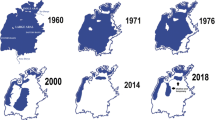The Aral Sea, despite being the 4th largest lake in the world up to 1960, has now split into six separate water bodies. This break-up and desiccation resulted overwhelmingly from upstream irrigation withdrawals from the two main influent rivers, the Syr Darya and the Amu Darya. The negative effects on both the lake's ecosystem due to declining water level and increasing salinity, as well as the profound socioeconomic and human impacts to the riparian populations are well documented. This paper focuses on the conservation and rehabilitation efforts of the remnant water bodies with a focus on four key areas: the Northern (Small) Aral and its ecosystem; the Southern (Large) Aral and its ecosystem; the delta and deltaic water bodies of the Syr Darya; and the delta and deltaic water bodies of the Amu Darya. It is encouraging to note the reversal of degradation in the Northern Aral after the creation of a dike at Berg's Strait in 1992. The dike washed out in 1999 but has been replaced with a new structurally sound dike. The water level in the Northern Aral has increased several meters and salinity is returning to levels that can sustain the pre-1960 ecosystem. However, much less success has been seen regarding the Southern Aral, which continues its retreat and hypersalinization. There have been recent efforts also in the
Access this chapter
Tax calculation will be finalised at checkout
Purchases are for personal use only
Preview
Unable to display preview. Download preview PDF.
Similar content being viewed by others
References
Aladin, N. V., Plotnikov, I. S., Potts, W. T. W. 1995. The Aral Sea desiccation and possible ways of rehabilitating and conserving its Northern part. Int. J. Environmetrics, 6: 17–29.
Aladin, N.V., Plotnikov, I.S., Smurov, A.O., Gontar, V.I. 2004. The role of introduced animal species in the ecosystem of the Aral Sea. In: Biological invasions in aquatic and terrestrial ecosystems. Moscow-St.Petersburg. pp. 275–296 (in Russian).
Aladin, N.V., Plotnikov, I.S. 1995. Changes in the Aral Sea level: palaeolimnological and archaeological evidences. Proc. Zool. Inst. Russian Acad. Sci., 262: 17–46 (in Russian).
Andreeva, S.I., Andreev, N.I. 2003. Evolutional transformations of the Aral Sea bivalves under conditions of ecological crisis. Omsk State Pedagogical University. 382 pp. (in Russian).
Atlas of the Aral Sea invertebrates. 1974. Moscow: “Pischevaya Promyshlennost”, 272 pp.
Asarin, A, Bortnik, V. (compiled data). 1987. Annual Data on the Aral Sea Water Balance 1926–85. Inst. Water Probl., USSR Acad. Sci.Hydro Facil. Des. Inst., Gidroproyekt.
Boomer, I., Wünnemann, B., Mackay, A., Austin, P., Sorrel, P., Reinhardt, C., Keyser, D., Guichard, F., and Fontugne, M. 2008 (in press, corrected proof). Advances in understanding the late Holocene history of the Aral Sea region. Quaternary International, available online March 27, 2008
Boroffka, N.G.O., Obernhänsli, H., Achatov, G.A., Aladin, N.V., Baipakov, K.M., Erzhanova, A., Hörnig, A., Krivonogov, S., Lobas, D.A., Savel'eva, T.V., and Wünnemann, B. 2005. Human settlements on the northern shores of Lake Aral and water level changes. Mitigation and Adaptation Strategies for Global Change, 10: 71–85.
Bortnik, V.N., Chistyaevaya, S.P (eds.). 1990. Gidrometeorologiya i gidrokhimiya morey SSSR [Hydrometeorology and Hydrochemistry of the Seas of the USSR], vol. VII, Aral'skoye more [Aral Sea] (Leningrad: Gidrometeoizdat).
Expedition 2007. Information and data gathered during an expedition to the Aral Sea, September 16–29, 2007.
Expedition 2005. Information and data gathered during an expedition to the Aral Sea, August 22-September 23, 2005, funded by the Committee on Research and Exploration, National Geographic Society, Grant 7825-05.
Final Report, 2004. Final report of NATO Science for Peace Project 974101: Sustainable Development of Ecology and Land and Water Use through Implementation of a GIS and Remote Sensing Center in Karakalpakstan, Uzbekistan.
Ptichnikov, A. (ed.). 2002. Bulletin No. 3, NATO Science for Peace Project 974101: Sustainable Development of Ecology, Land and Water Use through Implementation of a GIS and Remote Sensing Centre in Karakalpakstan, Uzbekistan, in Russian and English.
Ptichnikov, A. (ed.). 2000. Bulletin No. 1, Nato Science for Peace Project No. 974101: Sustainable Development of Ecology and Land and Water Use through Implementation of a GIS and Remote Sensing Center in Karakalpakstan, Uzbekistan, in Russian.
Reinhardt, C., Wünnemann, B., and Krivonogov, S. K. 2007. Geomorpholological evidence for the late Holocene evolution and the Holocene lake level maximum of the Aral Sea, Geomorphology, 93: 302–315.
Water balance models, 1990–2007. Excel based linked physical water balance models of Small and large Aral Seas developed and updated by P. Micklin.
Uzglavgidromet. 1994–2003. Hydrologic and other data acquired by Philip Micklin from 1994–2003 from Uzglavgidromet [Main Administration of Hydrometeorology for Uzbekistan] in Tashkent, Uzbekistan.
Zenkevich, L.A. 1977. Classification of brackish water bodies taking seas of the USSR as example. Selected works. Vol. 1. Biology of northern and southern seas of the USSR. Moscow: “Nauka”. 339 pp. (in Russian).
Author information
Authors and Affiliations
Editor information
Editors and Affiliations
Rights and permissions
Copyright information
© 2008 Springer Science + Business Media B.V.
About this paper
Cite this paper
Aladin, N., Micklin, P., Plotnikov, I. (2008). Biodiversity Of The Aral Sea And Its Importance To The Possible Ways Of Rehabilitating And Conserving Its Remnant Water Bodies. In: Qi, J., Evered, K.T. (eds) Environmental Problems of Central Asia and their Economic, Social and Security Impacts. NATO Science for Peace and Security Series C: Environmental Security. Springer, Dordrecht. https://doi.org/10.1007/978-1-4020-8960-2_5
Download citation
DOI: https://doi.org/10.1007/978-1-4020-8960-2_5
Publisher Name: Springer, Dordrecht
Print ISBN: 978-1-4020-8959-6
Online ISBN: 978-1-4020-8960-2
eBook Packages: Earth and Environmental ScienceEarth and Environmental Science (R0)




